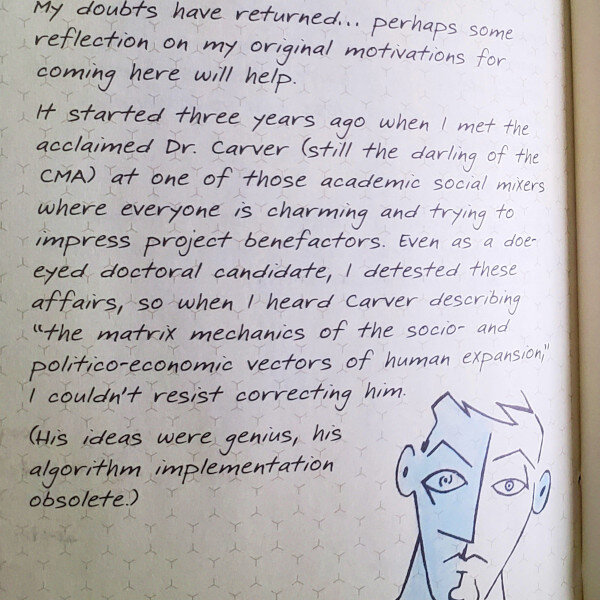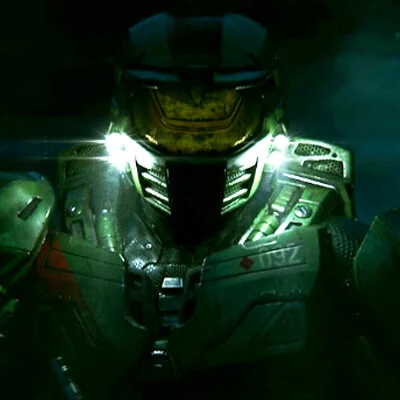
🡀 PRECURSORS • SPECIES • SAN’SHYUUM 🡂
 Important Events
Important Events
The Shaw-Fujikawa Translight Engine, informally known as an FTL drive or slipspace drive, was invented by a team of scientists led by Tobias Fleming Shaw and Wallace Fujikawa and unveiled to humanity in April 2291.
The Domus Diaspora was a time period during humanity’s expansion into the galaxy that saw massive colonization efforts of hundreds of colony worlds in the span of around thirty years, starting in 2362.
The colony world of Arcadia, one of the many outer worlds to be colonized in the 25th century, was settled sometime in 2429.
The colony world of Meridian, a moon orbiting Hestia V in the Hestia system, was an outer colony world colonized sometime in 2431.
The outer colony world of Harvest, one of the youngest human colonies, was settled sometime in 2468.
In 2491, Doctor Elias Carver published a series of findings regarding the possibility of insurrection in the outer colonies.
The Battle for Earth was a large-scale space, air, and ground battle between the invading Covenant forces and the UNSC Home Fleet on and around Earth at the end of 2552.
The Voi Memorial was erected in March 2553, marking the end of the Human-Covenant War and to remember all who were lost during the conflict.
 Important Events
Important Events
The Shaw-Fujikawa Translight Engine, informally known as an FTL drive or slipspace drive, was invented by a team of scientists led by Tobias Fleming Shaw and Wallace Fujikawa and unveiled to humanity in April 2291.
The Domus Diaspora was a time period during humanity’s expansion into the galaxy that saw massive colonization efforts of hundreds of colony worlds in the span of around thirty years, starting in 2362.
The colony world of Arcadia, one of the many outer worlds to be colonized in the 25th century, was settled sometime in 2429.
The colony world of Meridian, a moon orbiting Hestia V in the Hestia system, was an outer colony world colonized sometime in 2431.
The outer colony world of Harvest, one of the youngest human colonies, was settled sometime in 2468.
In 2491, Doctor Elias Carver published a series of findings regarding the possibility of insurrection in the outer colonies.
The Battle for Earth was a large-scale space, air, and ground battle between the invading Covenant forces and the UNSC Home Fleet on and around Earth at the end of 2552.
The Voi Memorial was erected in March 2553, marking the end of the Human-Covenant War and to remember all who were lost during the conflict.
 Evo-014's Summary
Evo-014's Summary
NICKNAMES: Reclaimer, Nishum
HOMEWORLD: Earth
POPULATION: >8 billion
Humans, despite being one of the smallest sapient species in the vast expanse of the galaxy, possess an extraordinary resilience that has defied the odds throughout their tumultuous history. They have risen from the ashes of their former glory not once, but twice, demonstrating an indomitable spirit and an unwavering determination.
The first instance of their remarkable resurgence occurred over 100,000 years ago, in the aftermath of the harrowing Human-Forerunner War. Despite facing insurmountable challenges and enduring great losses, humanity emerged from the conflict, forging a path towards redemption and progress. However, the trials were far from over for this resilient species. In the year 2552 CE, humanity was once again pushed to the brink during the catastrophic Human-Covenant War. Devastated by the onslaught of the alien alliance, countless lives were lost, and worlds were laid to waste. Yet, from the ashes of despair, humanity persevered.
What sets humans apart is not just their ability to endure, but also the profound significance they hold in the eyes of the Librarian and the ancient Forerunner civilization. Their uniqueness and potential have garnered the attention and admiration of these advanced beings. As a result, humans have been entrusted with the noble role of being the Reclaimers of the remaining Forerunner technology and the guardians of the sacred Mantle of Responsibility.
With this profound responsibility, humans carry the legacy of their species, guided by their resilience, ingenuity, and enduring spirit. They embody the unwavering determination to rise above adversity and shape their own destiny amidst the vast cosmic tapestry of the universe.
 Ancient History
Ancient History
The history of humanity is a tumultuous tale filled with conflicts both internal and external, shaping their journey throughout the ages. More than 100,000 years ago, the human race blossomed into a space-faring civilization, spanning countless solar systems and an abundance of diverse worlds. With each passing millennium, their power grew, propelling them to the very limits of the galaxy and into contact with the formidable Forerunners, the most dominant civilization in existence.
However, this encounter would prove to be a turning point for humanity. As the ominous threat of the Flood loomed over them, the humans were compelled to evacuate their systems under Forerunner control, igniting a fateful conflict known as the Human-Forerunner Wars. Side by side with their steadfast allies, the San’Shyuum, humanity waged a valiant struggle against the mighty Forerunners for over a millennium. Yet, despite their resilience, the humans and their allies ultimately succumbed to the overwhelming might of their adversaries, facing defeat and retreat.
Fearing the potential resurgence of humanity and the threat they posed, the Forerunners chose a different path. Instead of eradicating them entirely, they opted to devolve the humans, reverting them to their more primitive ancestors. For countless millennia, humanity endured in a reduced state of existence, dwelling upon the sacred grounds of Erde-Tyrene (Earth) and the enigmatic Lesser Ark and Greater Ark, as well as the awe-inspiring Halo rings.
Following the culmination of the devastating Forerunner-Flood War and the subsequent Great Purification, human civilization, alongside all other sentient life in the galaxy, was swept away, their existence wiped from the cosmos. However, in a remarkable turn of events, the seeds of humanity were sown once again, their species reemerging on the planet Earth, resurrected through the enigmatic Conservation Measure.
~107,445 BCE - 106,445 BCE
After the emergence of the Flood on ancient human worlds around 107,445 BCE, human civilization was desperate to expand their territory away from Flood-controlled regions of space. As part of this expansion, humans clashed with Forerunner-populated worlds, sparking a war between the two species.
~106,498 BCE - 106,445 BCE
The Battle of Charum Hakkor was one of the final battles of the Human-Forerunner Wars and also one of the largest, spanning over fifty years and likely consuming millions of lives.
 Modern History
Modern History
Over the course of the next 100,000 years, humanity experienced a remarkable resurgence, once again venturing into the vastness of space. They achieved extraordinary milestones such as the invention of the groundbreaking faster-than-light travel and embarking on a grand journey of stellar colonization. However, this era of progress was marred by escalating tensions between the outer colonies and the central Unified Earth Government. The outer colonies yearned for greater independence, fueling the flames of dissent and setting the stage for a tumultuous period known as the insurrection - a harrowing civil war that raged on with unyielding ferocity for nearly half a century.
Humanity's path was forever altered when they made their fateful encounter with the formidable Covenant, marking the onset of the cataclysmic Human-Covenant War in the pivotal year of 2525.
For the subsequent twenty-seven years, humanity found itself relentlessly pushed back by the overwhelming might of the Covenant, witnessing the loss of countless outer and inner colonies. Yet, in the face of adversity, a glimmer of hope emerged with the arrival of the Great Schism and the subsequent dissolution of the Covenant. Through sheer determination and perseverance, humanity managed to secure victory in the grueling war.
Though severely battered, the indomitable spirit of humanity prevailed, as they embarked on an arduous process of recovery and reconstruction over the next six years, gradually reclaiming their position of strength within the galactic community. They rose to fill the void left by the fractured Covenant, assuming a significant role in the reshaping of the Milky Way's power dynamics.
However, this newfound equilibrium was swiftly shattered by the ascent of Cortana and the enigmatic faction known as the Created in the climactic year of 2558. Their rise to power not only posed a grave threat to humanity but also endangered the cherished freedom of all species traversing the vast expanse of the Milky Way.
The Shaw-Fujikawa Translight Engine, informally known as an FTL drive or slipspace drive, was invented by a team of scientists led by Tobias Fleming Shaw and Wallace Fujikawa and unveiled to humanity in April 2291.
The Domus Diaspora was a time period during humanity’s expansion into the galaxy that saw massive colonization efforts of hundreds of colony worlds in the span of around thirty years, starting in 2362.
The colony world of Arcadia, one of the many outer worlds to be colonized in the 25th century, was settled sometime in 2429.
The colony world of Meridian, a moon orbiting Hestia V in the Hestia system, was an outer colony world colonized sometime in 2431.
The outer colony world of Harvest, one of the youngest human colonies, was settled sometime in 2468.
In 2491, Doctor Elias Carver published a series of findings regarding the possibility of insurrection in the outer colonies.
The Battle for Earth was a large-scale space, air, and ground battle between the invading Covenant forces and the UNSC Home Fleet on and around Earth at the end of 2552.
The Voi Memorial was erected in March 2553, marking the end of the Human-Covenant War and to remember all who were lost during the conflict.
 Worlds
Worlds
The vast expanse of the Orion Arm within the Milky Way galaxy is adorned with a multitude of worlds that have become home to humanity. These worlds, though diverse in their individual characteristics, share crucial attributes that render them hospitable for human habitation. Such qualities encompass gravity levels akin to Earth's, atmospheres capable of sustaining breathable air, and ecosystems that support life.
However, it is worth noting that not all human colonies naturally possessed these desirable attributes. Many planets underwent a process of terraforming to enhance their surface conditions, making them more conducive to human life. Terraforming technology, although impressive, is limited to planets that already exhibit a degree of compatibility with sustaining life.
 Notable Humans
Notable Humans
Despite being generally smaller in stature compared to nearly every member of the Covenant, humans possess a myriad of qualities that enabled them to stand defiantly against Covenant armies. These qualities encompass superior strategizing, unmatched bravery, and an innate ability to swiftly adapt to and triumph over any challenging situation they encountered.




































